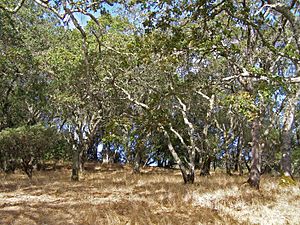Graham Creek (Sonoma County, California) facts for kids
Quick facts for kids Graham Creek |
|
|---|---|
| Country | United States |
| State | California |
| Region | Sonoma County |
| Physical characteristics | |
| Main source | Sonoma Mountain 3 mi (5 km) west of Glen Ellen, California 2,160 ft (660 m) 38°20′44″N 122°34′26″W / 38.34556°N 122.57389°W |
| River mouth | Sonoma Creek 1 mi (2 km) northwest of Glen Ellen, California 282 ft (86 m) 38°22′10″N 122°32′20″W / 38.36944°N 122.53889°W |
Graham Creek is a stream in Sonoma County, California. It flows for about 2.9 miles (4.7 km) and is a branch of Sonoma Creek. Graham Creek starts in the northern Sonoma Mountains. It then flows northeast down the side of Sonoma Mountain.
Long ago, this stream was called Wild Water Creek. The famous writer Jack London knew this name. He even found inspiration for some of his stories from this stream. Fish like steelhead used to swim up Graham Creek from Sonoma Creek to lay their eggs. Studies from 1966 to 1986 showed that these fish populations were getting smaller. But Graham Creek is still a good place for fish to lay eggs. It offers safe spots for them in both winter and summer.
The land around Graham Creek is mostly open space, farms, and some homes. Most of the area is covered with native California oak woodlands. These woodlands are home to many different plants and animals. In the past, starting in the 1800s, too much animal grazing caused some harm to the environment. But much of this damage has been fixed today.
Contents
History of Graham Creek
Long ago, prehistoric Pomo and Wappo people used the Graham Creek area. They were hunter-gatherers who moved around to find food and trade. The first written records show that this land was part of a Spanish land grant in the 1860s.
By the late 1890s, much of the lower stream area was overgrazed by animals. Jack London noticed this when he bought many ranches there in the early 1900s. He wanted to fix the environmental damage. This damage was caused by building small dams and by animals grazing too much. These changes were made by early European settlers.
Ecology and Wildlife
The forests along Graham Creek are very green and have tall trees. This is because the eastern side of Sonoma Mountain is steep and moist. This climate helps trees grow tall and strong. The most common type of forest here is the California oak woodland.
Plants of the Woodland
The main trees in these woodlands include coast live oak, Garry oak, black oak, Pacific madrone, bigleaf maple, and California laurel. In some steeper, cooler areas, you can also find small groups of coast redwood trees.
Underneath these tall trees, you'll find plants like toyon, blackberry, and western poison-oak. In drier spots, there's some coyote brush.
Animals of the Woodland
Many animals live here. You can often see black-tailed deer, gray squirrels, raccoons, skunks, and opossums. Sometimes, you might even spot a bobcat or a mountain lion.
There are also many birds, such as the scrub jay, Steller's jay, Acorn woodpecker, and junco.
Fish and Stream Health
Scientists have studied how anadromous fish move in Graham Creek. These are fish that live in the ocean but come to fresh water to lay eggs. Studies show that over time, there have been fewer places for these fish to lay eggs. This is mainly because of dirt washing into the stream. Also, some plants along the stream were removed since the 1800s.
However, Graham Creek's steep sides helped protect it more than other streams. Grazing animals couldn't easily walk into the stream beds here. This means the stream's steepness helped keep its banks and water cleaner.


